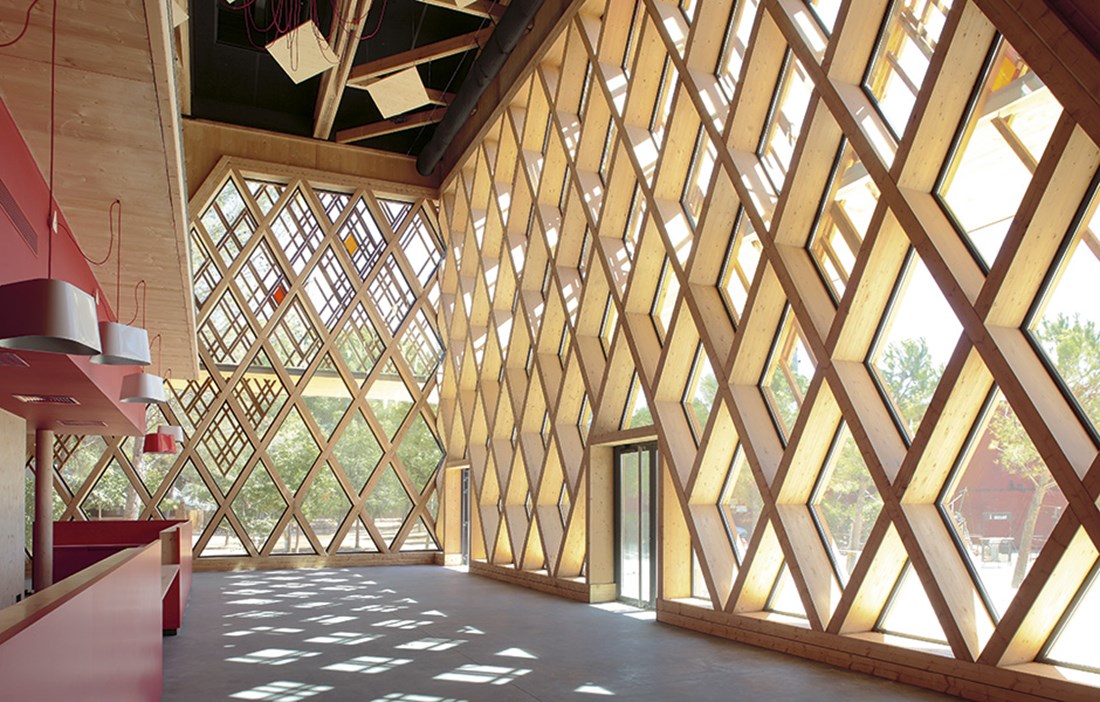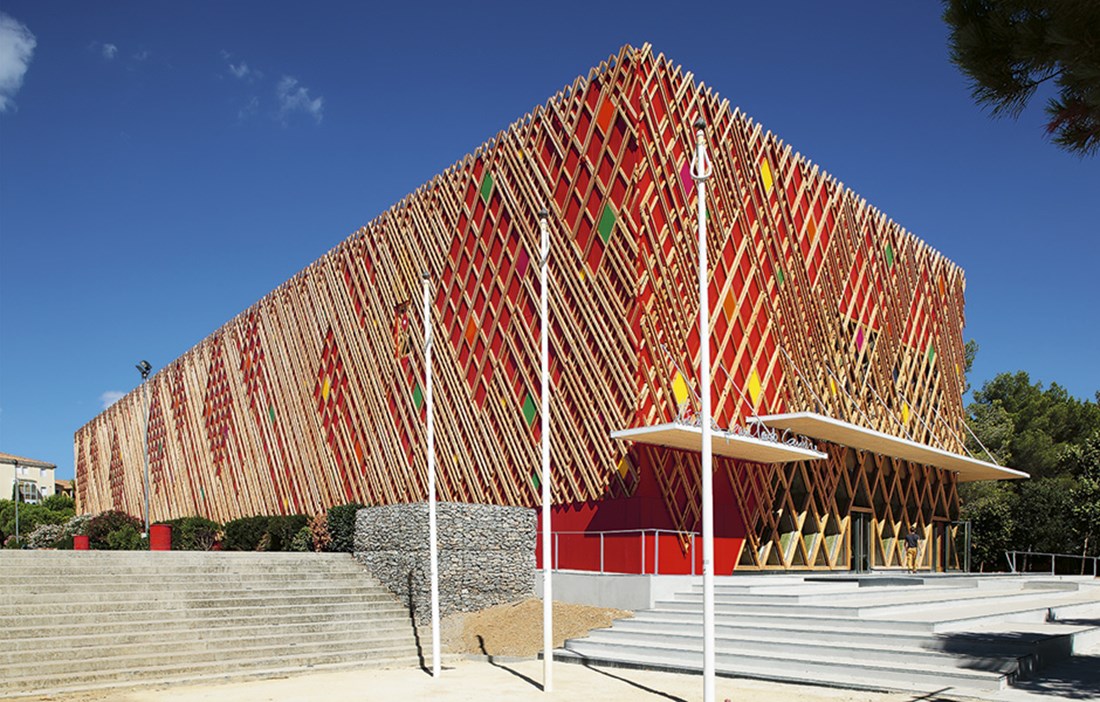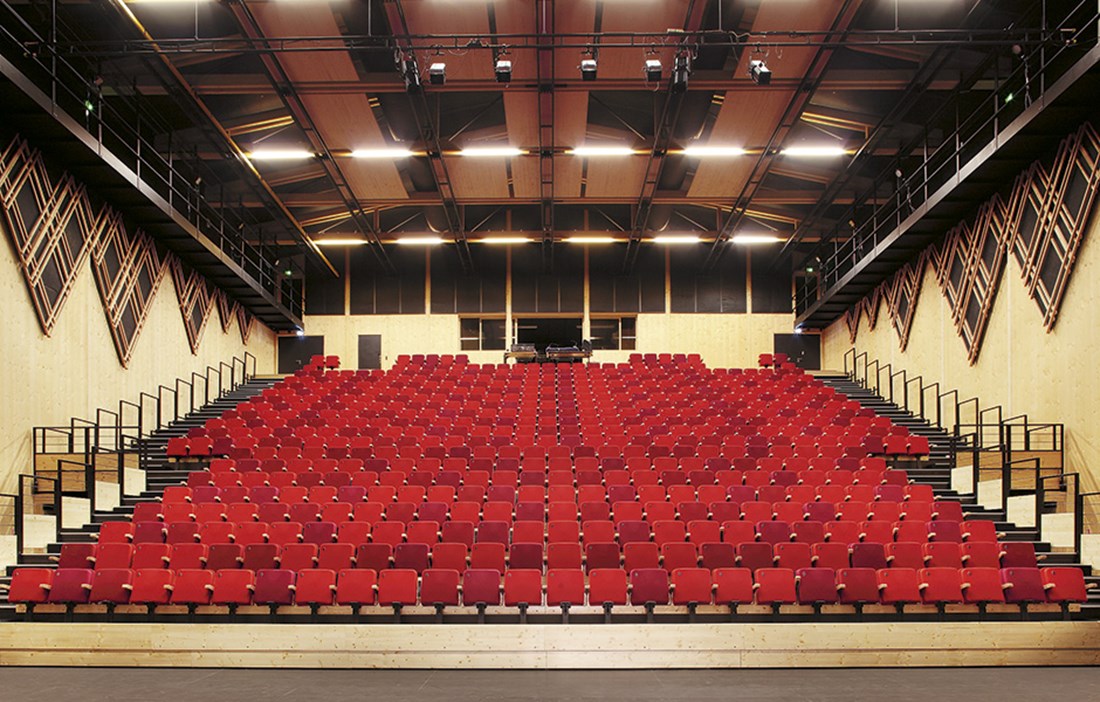AS DUSK SLOWLY descends over the olive groves of the classic culture park Domaine d’O, the buzz of the cicadas gets louder. The acoustic talents of the insects are well known and impossible to avoid. Equipped with an advanced resonance apparatus on the stomach, they create a dense wall of sound reaching up to 120 decibels.
Inside the Théâtre Jean-Claude Carrière, however, all is quiet. Sound from outside – and inside – is effectively damped by the theatre’s insulated double wooden walls. The French theatre stands in the middle of the Domaine d’O park, in Montpellier’s 23 hectare cultural oasis for art exhibitions, festivals and events. The Théâtre Jean-Claude Carrière, which is named after a famous screenwriter born in the area, is the park’s latest addition, built entirely in wood. The theatre rises up like a colourful cube in the middle of the park among the pines, olive trees and pleasant small gardens that are just made for a Sunday picnic.
The first thing to strike passers-by is the theatre’s facade, with its playful patterns of hundreds of rhombuses – diamonds if you will – created using long criss-crossing planks of wood, that climb up all the walls of the building. In some of the rhombuses, lamps shine in different colours.
“We had an idea that the pattern of the classic Harlequin costume should be a theme running throughout the theatre. So we thought about different ways of applying that concept. In the end, we decided to create a sort of diamond-shaped wooden lattice on the theatre’s facade,” explains Philippe Bonon, one of the lead architects at A+ Architecture.
The pattern is also repeated inside the theatre. As you walk through the entrance which, with its small protruding canopy roofs gives the impression of ducking under an enormous blanket, into the world of theatre you encounter yet more diamond patterns. The light and airy lobby is dominated by rhombus shaped windows that create an attractive play of light and shade – an effect that changes through the day as the sun moves across the sky. The aesthetic properties of the theatre are much appreciated by its visitors.
“The building should exude lightness and imagination, a place where anything can happen. We were so pleased when we heard the comments from the first visitors. They said they enjoyed the atmosphere and the warm scent of wood, in the lobby and when they went and took their seats. It’s naturally important for us that the visitors appreciate the acoustic properties of the auditorium, but also its architecture and aesthetic.”
The Théâtre Jean-Claude Carrière is the first building that A+ Architecture has designed entirely in wood. The choice of wood came primarily from the top priority of their client – the building was to be France’s first eco-theatre.
“Normally a project on this scale will take between 30 and 50 years to cover its energy use. We were conscious of this parameter and wanted to significantly improve on it. We therefore decided only to use sustainable and energy-efficient materials, which is what led us to build the entire theatre in wood, and to choose the other materials – rubber flooring, paints and glass – with equal care. According to our calculations, our project will take just seven years to cover its energy use.”
THE THEATRE HAS all sorts of standout eco-credentials. With its excellent insulation, a smart heating system and its use of low-energy LED lamps throughout – including on stage – the building is a highly energy-efficient creation. Electricity is also saved by allowing plenty of light in through the roof. The material’s interplay with the dynamic Mediterranean climate has also been exploited. Having a roof that can be opened and closed reduces the need for air conditioning. However, with capacity for an audience of 1800 people (1200 standing and 600 seated) and with actors and spotlights on the stage (even if they are LED lamps that generate less heat than others), fans are required to regulate the temperature.
Another stipulation from the client, the local council – Conseil Général de l’Hérault, was that the building could be dismantled and relocated if required. This was part of the vision for the theatre to be able to disseminate culture even beyond Montpellier in the future. This became another reason for building in wood. If it was going to be possible to assemble and disassemble the building, thought also needed to be given to the impact that process would have on the surroundings. Using prefabricated wooden panels reduced both the construction time and the impact on the environment around the construction site. In all, from idea to opening, the process took just one year.
THE THÉÂTRE JEAN-CLAUDE CARRIÈRE stands in a 300 year-old park where culture has always played an important role. When planning the theatre, it was only natural to take this into account.
“We were inspired by the park and the world of theatre, both of which have a strong identity and a long history. We therefore wanted our building to be in dialogue with them both. The red colour of the building is a classic theatre colour, and it combines with the rhombus pattern outside to provoke immediate theatrical associations. The pine forest in which the theatre sits also gave us ideas! It’s a wonderfully tranquil oasis, a place to free your mind. The forest and the wooden theatre lift and augment each other – making them both even more beautiful.”
The theatre’s characteristic red colour comes from the FunderMax panelling, a durable compact laminate. The wooden lattices that cover much of the facade are made from untreated French larch. The theatre’s frame, roof trusses and structural elements are made from glulam beams. The interior of the roof and walls is then clad in cross-laminated timber panels. The ceiling is lined with a moisture barrier to protect the wood panels from rising moisture emanating from inside the theatre. All the interior wood is untreated, so that it can age naturally. Only certain details such as skirting, wet rooms and toilets have been given a coat of varnish, a surface treatment that will need to be repeated on a regular basis.
All the wood in the building – around 1200 cubic metres – is PEFC certified, which means the timber has been harvested and processed in line with internationally established standards that guarantee sustainable forestry. The theme of sustainability runs through the whole project, not just in the choice of materials, but throughout the life cycle of the building, including transport to and from the construction site, for example.
Wood was also important in achieving the right acoustic properties for the theatre. Details in the auditorium that are there to improve the acoustics in the hall even become part of the scenography.
“We designed everything to have a function, and to follow the architectural concept of the building. We wanted it all to link together in a very visible way. We fitted the walls inside the auditorium at a specific angle that allows every sound and movement to be heard during the performances and reduces unwelcome echoes. The result is a theatre with huge potential, which can host all sorts of cultural and artistic activities.”
SINCE THIS IS A PUBLIC BUILDING, it is classified in France as an Establishment Receiving Public (ERP) and must therefore follow the stringent rules concerning this category of building. This affects design aspects such as corridor width and number of emergency exits, as well as the location of these. The criteria are, however, slightly less strict for this type of building, constructed around a wooden frame, than for buildings with a steel structure. This is because wooden constructions are known to tolerate heat better and remain standing for longer in the event of a fire.
“The load-bearing structure and substantial panelling on the walls offer natural fireproofing, thanks to their sheer size, and so did not need to be treated,” says Philippe Bonon.
A+ Architecture is pleased with the finished result. The only negative aspect the architects can come up with is that they will miss the construction site.
“This is the first time in our firm’s history that we’ve used wood to such an extent. It’s taught us so much about the material – and about architecture! For instance, we now know what a site is like when working exclusively with wood. It’s a very clean and pleasant place to work. We did it for a whole year, every day, and we’re going to miss it a lot. If we get the chance, we’d very much like to work even more with wood in the future,” concludes Philippe Bonon.
Text Erik Bredhe























